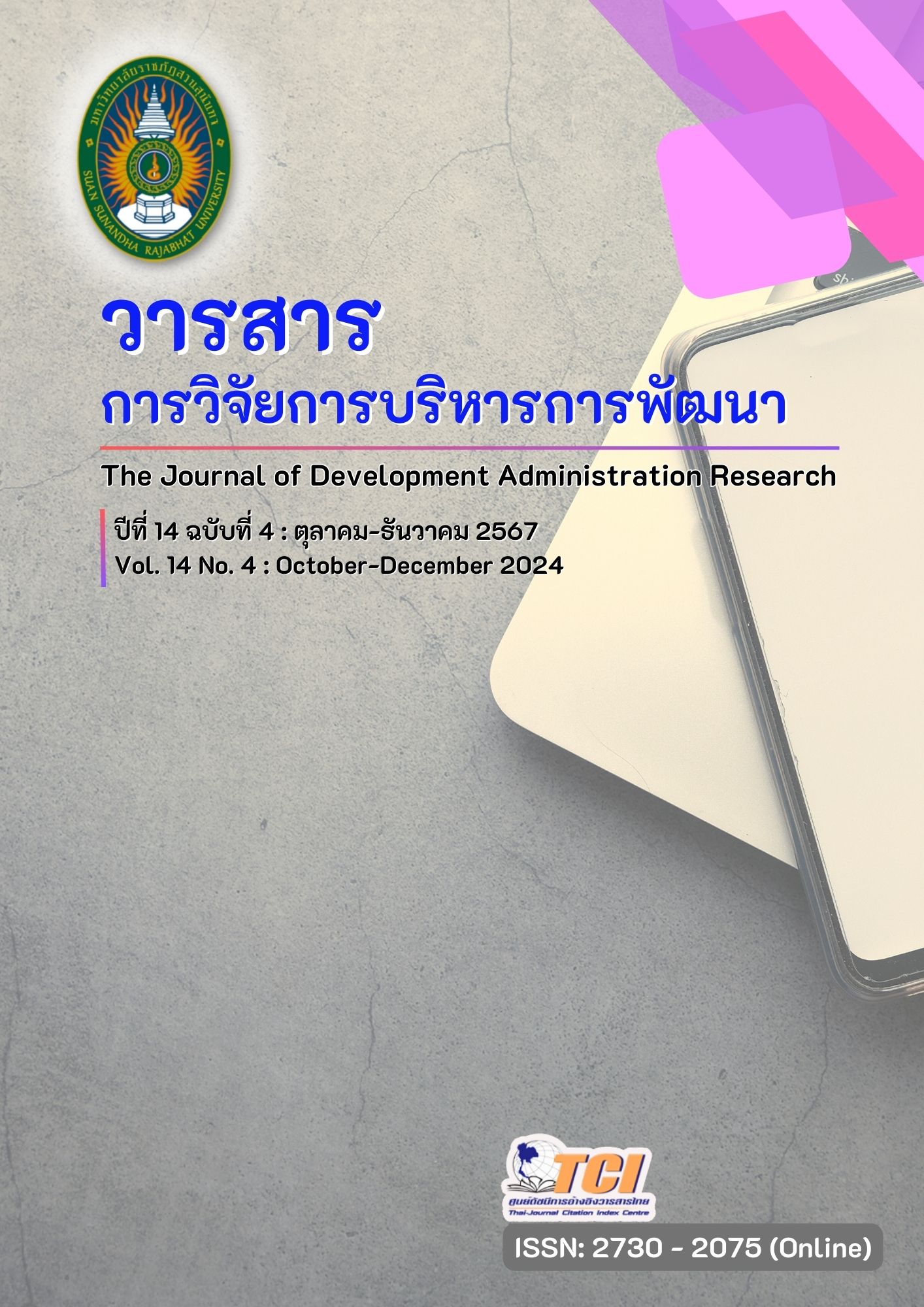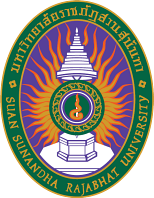อิทธิพลของวัฒนธรรมองค์การและการรับรู้ความสามารถของตนเอง ในฐานะตัวแปรคั่นกลางที่ส่งผลต่อความสัมพันธ์ระหว่างภาวะผู้นำการเปลี่ยนแปลงและความสามารถในการปฏิบัติงานสำหรับภาคอุตสาหกรรมยานยนต์ ช่วงเวลาของการเปลี่ยนแปลง
คำสำคัญ:
อุตสาหกรรมยานยนต์, ภาวะผู้นำการเปลี่ยนแปลง, ความสามารถในการปฏิบัติงานบทคัดย่อ
บทความนี้มีวัตถุประสงค์ 1) เพื่อวิเคราะห์องค์ประกอบเชิงยืนยันของตัวแปรด้านภาวะผู้นำการเปลี่ยนแปลง วัฒนธรรมองค์การ การรับรู้ความสามารถของตนเอง และความสามารถในการปฏิบัติงานของผู้ปฏิบัติงานในภาคอุตสาหกรรมยานยนต์ในช่วงเวลาของการเปลี่ยนแปลง 2) เพื่อศึกษาอิทธิพลทางตรง อิทธิพลทางอ้อมของตัวแปรที่มีอิทธิพลต่อความสัมพันธ์ระหว่างผู้นำการเปลี่ยนแปลงและความสามารถในการปฏิบัติงานสำหรับภาคอุตสาหกรรมยานยนต์ในช่วงเวลาของการเปลี่ยนแปลง รูปแบบการวิจัยเป็นการวิจัยแบบผสานวิธี กลุ่มตัวอย่างแบ่งเป็น 2 กลุ่ม คือ 1) การวิจัยเชิงคุณภาพ ได้แก่ ผู้ที่มีส่วนเกี่ยวข้องในภาคอุตสาหกรรมยานยนต์ จำนวน 12 คน ใช้วิธีคัดเลือกแบบเจาะจง เก็บข้อมูลโดยการสัมภาษณ์เชิงลึก และการวิเคราะห์เชิงเนื้อหา 2) การวิจัยเชิงปริมาณ กลุ่มตัวอย่าง 440 คน เก็บข้อมูลโดยใช้แบบสอบถามรูปแบบออนไลน์จากผู้ปฏิบัติงานในพื้นที่นิคมอุตสาหกรรม ใช้วิธีการสุ่มตัวอย่างตามความสะดวก เพื่อวิเคราะห์องค์ประกอบเชิงยืนยัน วิเคราะห์สมการเชิงโครงสร้าง และวิเคราะห์สถิติเชิงพรรณนา
ผลการศึกษา พบว่า 1) โมเดลมีความสอดคล้องกับข้อมูลเชิงประจักษ์ ตัวแปรทุกตัวมีความเข้ากันได้ดีและเป็นไปตามเกณฑ์ สอดคล้องกับข้อมูลเชิงประจักษ์ ได้แก่ (1) ด้านภาวะผู้นำมีอิทธิพลทางตรงเชิงบวกต่อวัฒนธรรมองค์การ การรับรู้ความสามารถของตนเองและความสามารถในการปฏิบัติงาน (2) ด้านวัฒนธรรมองค์การมีอิทธิพลทางตรงเชิงบวกต่อการรับรู้ความสามารถของตนเองและความสามารถในการปฏิบัติงาน และ (3) ด้านการรับรู้ความสามารถของตนเองมีอิทธิพลทางตรงเชิงบวกต่อความสามารถในการปฏิบัติงาน และ 2) ภาวะผู้นำมีอิทธิพลทางอ้อมเชิงบวกต่อความสามารถในการปฏิบัติงาน โดยมีรับรู้ความสามารถของตนเอง และวัฒนธรรมองค์การเป็นตัวแปรส่งผ่านและพบว่าวัฒนธรรมองค์การมีอิทธิพลทางอ้อมเชิงบวกต่อความสามารถในการปฏิบัติงาน โดยมีการรับรู้ความสามารถของตนเองเป็นตัวแปรส่งผ่านและสามารถพยากรณ์ความสามารถในการปฏิบัติงาน ได้ร้อยละ 41 ที่ระดับนัยสำคัญทางสถิติ .05
เอกสารอ้างอิง
กัลยา วานิชย์บัญชา. (2556). การวิเคราะห์สถิติ: สถิติสำหรับการบริหารและวิจัย. กรุงเทพฯ: ภาควิชาสถิติ คณะพาณิชยศาสตร์และการบัญชี จุฬาลงกรณ์มหาวิทยาลัย.
สถาบันพัฒนาข้าราชการพลเรือนสำนักงาน. (2553). คู่มือการพัฒนาข้าราชการตามสมรรถนะหลัก (Core Competencies) : หลักสูตรการพัฒนาสมรรถนะหลักและแนวทางการพัฒนาตามหลักสมรรถนะหลักทั้ง 5 สมรรถะ. กรุงเทพฯ: สถาบันพัฒนาข้าราชการพลเรือนสำนักงาน.
Apaydin, F. & Apaydin, F. (2018). Automobiles, Skill Formation and Development. In Technology, Institutions and Labor: Manufacturing Automobiles in Argentina and Turkey (pp. 39-71).
Bagis, F., Kusumo, U. I., & Hidayah, A. (2021). Job Satisfaction as A Mediation Variables on The Effect of Organizational Culture and Organizational Commitment to Employee Performance. International Journal of Economics, Business and Accounting Research (IJEBAR), 5(2), 424-434.
Bandura, A. (1977). Self-efficacy: Toward a unifying theory of behavioral change. Psychological Review, 84, 191-215.
Bass, B. M. (1985). Leadership and performance beyond expectations. New York: The Free Press.
Boyatzis, R. E. (1982). The competent manager: A model for effective performance. New York: Wiley.
Bükey, A. & Gülcan, B. (2022). Turizm ve Rekreasyonda Bandura’nın Öz-yeterlilik Teorisinin Bibliyometrik Analizi (Bibliometric Analysis of Studies on Albert Bandura's Theory of Self-Efficacy). Journal of Tourism & Gastronomy Studies, 10(3), 2296-2313.
Cameron, K. S. & Quinn, R. E. (2011). Diagnosing and changing organizational culture: Based on the Competing Values Framework (3rd ed.). San Francisco: Jossey-Bass.
Celasun, O., et al. (2023). Cars and the Green Transition: Challenges and Opportunities for European Workers. International Monetary Fund. Retrieved March 2, 2024, from https://www.imf.org/en/Publications/WP/Issues/2023/06/02/Cars-and-the-Green-Transition-Challenges-and-Opportunities-for-European-Workers-534091
Chartady, R. et al. (2023). The effect of competence and confidence on the performance of activities technical implementing officers (pptk) with motivation as intervening variables in government bintan regency. International Journal of Social Science, 3(1), 29-36.
Cherian, H. S., Chawla, T. K. & Lee, K. K. (2023). Employee Engagement and Organizational Culture in Automotive Firms in Japan. Journal of human resource & leadership, 7(3), 12-22.
Chiara, C., Diego, V. & Mara, S. (2023). Human Resource Management (Human Resource Planning). Sharia Oikonomia Law Journal, 1(1), 49-60.
Chis-Manolache, D. (2022). The importance of transformational leadership in organizations. Scientific Research & Education in the Air Force-AFASES, 2022, 127.
Daud, I., Novrianto, A. & Kurniawan, M. S. (2023). Unleashing Competence: Exploring the Influence of Organizational Culture, Emotional Intelligence and Learning Organization. Journal Informa tika Ekonomi Bisnis, 5(3), 691-697.
Fakhri, M., et al. (2020). Leadership style and its impact on employee performance at Indonesian national electricity company. The Open Psychology Journal, 13(1), 321-325.
Hair Jr., J. F., et al. (2014). Partial Least Squares Structural Equation Modeling (PLS-SEM): An Emerging Tool in Business Research. European Business Review, 26, 106-121.
Kotter, J. P. (1996). Leading Change. Boston: Harvard Business School Press.
Mai, N. K., Do, T. T. & Ho Nguyen, D. T. (2022). The impact of leadership competences, organizational learning and organizational innovation on business performance. Business Process Management Journal, 28(5/6), 1391-1411.
Mayer, C. H. & Wilke, K. (2022). Leading through VUCA times for a sustainable future of work: expert views on the global automotive industry. In: Leadership after COVID-19. Springer, Cham, pp 253–268.
Mcclelland, D. C. (1973). Testing for competence rather than for “intelligence”. American Psychologist, 28(1), 1–14.
Nastasi, B. K. & Schensul, S. L. (2005). Contributions of qualitative research to the validity of intervention research. Journal of School Psychology, 43(3), 177-195.
Olutoye, A. A. & Asikhia, O. (2022). The effect of leadership and organizational behavior on performance–A systematic literature review. International Academic Journal of Human Resource and Business Administration, 4(1), 165-183.
Pajares, F. (1996). Self-efficacy beliefs in academic settings. Review of Educational Research, 66(4), 543–578.
Thai PBS. (2567). ไทยเข้าสู่ยุครถยนต์ไฟฟ้า ยอดจำหน่ายทะยาน 700%. ค้นเมื่อ 2 มีนาคม 2567, จาก https://policywatch.thaipbs.or.th/article/economy-21
Popa, S. C., et al. (2023). Shaping the culture of your organization by the human capital: employees' competencies and leaders' perceived behavior. Journal of Intellectual Capital, 24(5), 1164-1183.
Purnomo, B. R., Eliyana, A. & Pramesti, E. D. (2020). The Effect of Leadership Style, Organizational Culture and Job Satisfaction on Employee Performance with Organizational Commitment as the Intervening Variable. Systematic Reviews in Pharmacy, 11(10), 446-458.
Reolfi, R. L., Fuchs, E. R., & Karplus, V. J. (2023). Anticipating the impacts of light-duty vehicle electrification on the US automotive service workforce. Environmental Research Letters, 18(3), 031002.
Reta, M. A. (2021). The influence of leadership styles on the effectiveness of the public policy implementation process in Ethiopia: the case of Addis Ababa city government. American Journal of Management Science and Engineering, 6(5), 142-160.
Schein, E.H. (1992). Organizational Culture and Leadership. San Francisco: Jossey-Bass.
Schumacher, R. E., & Lomax, R. G. (2010). A beginner’s guide to structural equation modeling (3rd ed.). New Jersey: Lawrence Erlbaum Associates.
Schunk, D. H., & Pajares, F. (2002). The development of academic self-efficacy. In A. Wigfield & J. S. Eccles (Eds.), Development of achievement motivation (pp. 15–31). Academic Press.
Spencer, L. M., & Spencer, S. M. (1993). Competence at Work: Models for Superior Performance. New York: John Wiley & Sons.
Sudarsono, B. et al. (2024). Development of an Integrated Electric Vehicle Learning Simulator (EVLIS) with Industry-Based Learning to Accelerate Work Readiness of Vocational School Students. Bulletin of Pedagogical Research, 4(1), 67-81.
Valdivia, C. A. S., et al. (2024). Dimensions of Digital Transformation for Digital Supply Chains Evidence from an Automotive OEM Group. Research-Technology Management, 67(2), 57-68.
Yukl, G. (2013). Leadership in Organizations. Boston: Pearson.
Zimmerman, B. J. (2000). Self-efficacy: An essential motive to learn. Contemporary Educational. Psychology, 25, 82-91.
ดาวน์โหลด
เผยแพร่แล้ว
รูปแบบการอ้างอิง
ฉบับ
ประเภทบทความ
สัญญาอนุญาต
ลิขสิทธิ์ (c) 2024 วารสารการวิจัยการบริหารการพัฒนา

อนุญาตภายใต้เงื่อนไข Creative Commons Attribution-NonCommercial-NoDerivatives 4.0 International License.
บทความที่ได้รับการตีพิมพ์เป็นลิขสิทธิ์ของมหาวิทยาลัยราชภัฏสวนสุนันทา
ข้อความที่ปรากฏในบทความแต่ละเรื่องในวารสารวิชาการเล่มนี้เป็นความคิดเห็นส่วนตัวของผู้เขียนแต่ละท่านไม่เกี่ยวข้องกับมหาวิทยาลัยราชภัฏสวนสุนันทา และคณาจารย์ท่านอื่นๆ ในมหาวิทยาลัยฯ แต่อย่างใด ความรับผิดชอบองค์ประกอบทั้งหมดของบทความแต่ละเรื่องเป็นของผู้เขียนแต่ละท่าน หากมีความผิดพลาดใดๆ ผู้เขียนแต่ละท่านจะรับผิดชอบบทความของตนเองแต่ผู้เดียว




